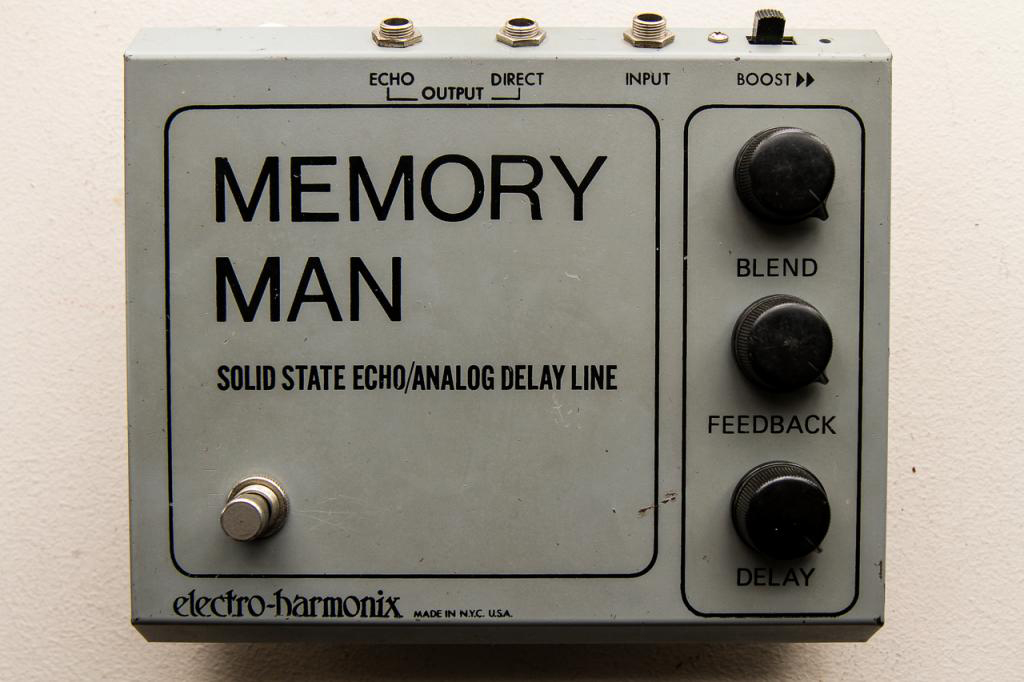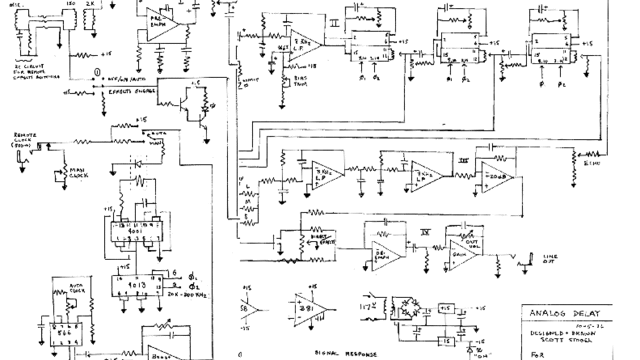Reel Talk: a Brief History of Delay
Reel Talk: a Brief History of Delay
Since its introduction to the commercial market in the early 1950’s delay has been a staple effect in studio recordings and live shows across almost all genres. Its ability to be manipulated to create space or rhythmical motifs has captivated guitarists and musicians alike across the years, and helped spawn some of our favourite music today. So lets get into it.
It began with tape delay, which was born out of an interest in using technology to recreate natural phenomenon (reverb, echo, etc) and uses reel-to-reel recording to achieve its sound. Put simply, reel-to-reel means you can record yourself playing and then control how and when the recorded version of yourself playing is repeated. It uses tape heads to control the recording (write head) and then a number of other tape heads to control the repeats (playback heads). Only problem with tape was that the machines were heavy, expensive, temperamental, and required regular maintenance.

Bring on solid-state analogue delay. A mainstream user- friendly alternative to tape delay brought out in the 1970’s, analogue uses bucket brigade chips to capture and repeat the delay rather than tape and tape heads. It uses a discrete- time analogue delay line, in which the capacitors in the chip store the analogue information, and pass it along the line one step at a time at a clock cycle. The name is a reference to the term bucket brigade, which refers to people passing a bucket of water in a line. However, as big a revolution as analogue delay was, it’s time in the spotlight was short lived.
With the availability of inexpensive digital signal processing electronics in the late 1970’s it wasn’t long before digital delay started to come through and take over the delay market. Originally introduced as expensive rack units, digital delay worked by sampling the input signal and then using the sample to create very clean delays, and allowed the user to have more control of the parameters of the delay itself. It went on to dominate the delay market for years before the resurgence of analogue and tape in the early 1990’s.
Its safe to say that discussing delay is no joke. You can spend hours learning about every facet of the three types of delays, and even longer working out which delay is right for you because there have been so many incarnations that its hard to know where to begin and what they can offer to your sound. What I’m going to try and do is give you a simplified version of each, the headlines if you will, and then bang over a couple of my personal recommendations for starter delays to get you going. Sound cool? Cool.
Digital Delay:
I’m going to do these in the order that I think are most user friendly for beginners, and you cant really get easier than digital delay.
The easiest way to imagine what digital delay sounds like is to think of The Edge’s guitar sound. He used a TC Electronic 2290 rack unit delay, one of the most famous digital delays ever made and the best reference for your classic digital delay. Think clean, bright, and perfect delay sounds, which you can shape and sculpt to your hearts content. Due to the
lack of analogue hardware circuitry, digital delays are capable of creating longer, more durable repeats that don’t degrade or oscillate, which is why it’s best suited for creating these rhythmical riffs seen in songs like Sweet Disposition, Where the Streets Have No Name, and Heartbreak Warfare. If you want clean and pristine, then digital is what you need.
Dan’s Pick: Boss DD3 (£99)
The DD3 was first introduced in 1985, and not much has changed about it since then. Its simple, easy to use interface and classic sound has kept guitar players happy for generations with its smooth repeats and tone, capable of creating anything from tight slap back to chaotic and endless tremolo picking. It’s the one stop shop for entry delays and you cant really get more for less anywhere else. Alternatively, if you are looking for slightly more control over your delay, look into the DD7. The most recent model in the DD series, the DD7 has an expression out which you can attach an external tap tempo footswitch to, allowing you more control over your delays for not much more money!
Analogue Delay:
Moving into the more complex delays, analogue delay provides a grainier sounding repeat with more expressive feedback, and is often paired with modulation to complete its classic sound. Analogue is best for musicians who are looking for a less control over traditional delay parameters, in exchange for a wilder side to the feedback of their delays. Analogue is famous for its feedback sound, the can make you sound like you’re lost in space or in the climax scene of a 1960’s horror film. If you want crazy feedback and little control over it, go analogue.
Dan’s Pick: EHX Memory Toy (£84)
One of the things I’ve enjoyed most about hunting for great deals on pedals for beginners, is that sometimes you find a pedal that’s just a great pedal all round for the price regardless of whether you’re a beginner or not! And that’s exactly what I’ve found with the Memory Toy. A compact affordable version of the iconic Memory Man, the Memory Toy delivers classic analogue tone and lush modulation in a compact and affordable package. Bar the Boss DM2, you can’t get more classic analogue than the Memory Man, and at £84 you really cant go wrong.
Tape Delay:
Arguably the hardest of the delays to become familiar with, mainly because most people don’t have access to a real one, tape delay is known for being the most “human” sounding delay of the three, and is often the most coveted due to its high price tag and rarity. Tape is a very versatile delay, being used initially to create dripping slap back tones in the early rockabilly days, before it was being used to create pseudo space age sounds by bands in the mid 1960’s, and has since been used by bands like Led Zeppelin, Pink Floyd, Radiohead, and so much more. Tape is known for is bright humanizing tone, and deep low end capable of creating sounds similar to the noises you’d expect to hear when the alien ships land and they make first contact. You want space age? Go tape.
Dan’s Pick: Mooer Reecho (£54)
Now anyone who knows anything about tape delay knows that usually if you want to buy one you’ve got two options; 1. Pay anywhere from £180-£450 pounds for a high quality digital recreation of a tape delay, or 2. Pay anywhere from £1000-£5000 pounds for an actual tape echo that requires an immense amount of care and maintenance. So I think it’s safe to say that usually, buying tape delay as a beginner is nothing more than a pipedream, until now. Introducing the Mooer Reecho, which in my opinion is THE best delay at is price point by a country mile. Aside from the fact it’s got a really convincing tape sound, it also has two different types of tape sounds AND an analogue one. It comes in a tiny
package, which is ideal for those people who are very conscious about their pedal board real estate, and if that wasn’t enough its only £54! I’m not saying it’s the best tape delay sound I’ve ever heard, but it is the most convincing sounding tape delay I’ve heard out of any of the tape emulators. It even beats tape delays that come in at higher price points! I can honestly say that in all my years of pedal hunting I have not found a pedal that offers this kind of quality at such a low price point. There is literally no downside to buying this pedal, period.
By
Dan Tredgold
Reel Talk; a Brief History of Delay

